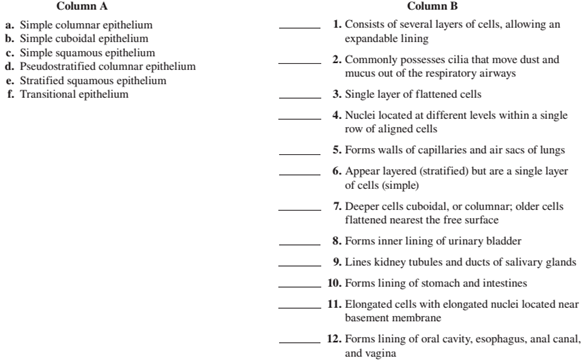
Concept explainers
Match the tissues in column A with the characteristics in column B. Place the letter of your choice in the space provided. (Some answers may be used more than once.)

To match:
The term from column A to the correct description in the column B.
INTRODUCTION:
In the complex body of the organisms which are multicellular in nature, different group of cells forms a tissue which performs various functions of the body like digestion, respiration, excretion etc. There are many cells and cellular layers which can be uni-layered or multi-layered,present in the body. Various tissues like epithelial tissue, connective tissue, muscular tissue and neural tissue are present in the multicellular organisms.
Answer to Problem 1.1A
The table below represents the correct match from the Column A to Column B.
| Column A | Column B | ||
| a. | Simple columnar epithelium | 7. 10. 11. | Deeper cells cuboidal, or columnar; older cells flattened nearest the free surface Forms lining of stomach and intestines Elongated cells with elongated nuclei located near basement membrane. |
| b. | Simple cuboidal epithelium | 9. | Lines kidney tubules and ducts of salivary glands |
| c. | Simple squamous epithelium | 3. 5. | Single layer of flattened cells Forms walls of capillaries and air sacs of lungs |
| d. | Pseudostratified columnar epithelium | 2. 4. 6. | Commonly possess cilia that move dust and mucus out of the respiratory airways Nuclei located at different levels within a single row of aligned cells Appeared layered (stratified) but are single layer of cells (simple) |
| e. | Stratified squamous epithelium | 12. | Forms lining or oral cavity, esophagus, anal canal, and vagina |
| f. | Transitional epithelium | 1. 8. | Consists of several layers of cells, allowing an expandable lining Forms inner lining of urinary bladder |
Explanation of Solution
- Simple columnar epithelium is a single layer lining. The term simple itself identifies it as a single layer and because it has slender, wider and comparatively longer cells hence the name columnar.It has microvilli on it in intestine and helps in more absorption and digestion of food particles also it is secretive in function because of which it helps in digesting food in the stomach by secreting digestive juices.
- Simple cuboidal epithelium as the name suggests has cells which are like cube in shape and it is also commonly found single layered only. It lines the glandular organs like kidney, liver, salivary glands etc. It helps in secreting various substances which helps in filtering blood in the kidney. Hence it also has secretory function.
- Simple squamous epitheliumhas flat, rounded and small cells with nucleus being placed centrally. They are not having a proper outline of the cell. They being thin cells helps in diffusion of various substances like air from respiratory tracts i.e. air sacs of lungs and also from blood vessels.
- Pseudostratified columnar epithelium is named so because the cells have nucleus at different levelswhich makes it appear as multi layers are present which is not actually true. The cells at free surface possess cilia which help in movement of mucous and prohibit foreign particles from entering the tract.
- Stratified squamous epitheliumis named so because strata mean layers, here the cells are actually arranged in layers so it’s a multilayered epithelium. The cells are lined upon as stacks. Its mainly responsible for the protection of our body from wear and tear. Therefore, it lines oral cavity, vagina, anal canal and so because at these places a lot of friction and trauma may occur which may result into injury of the underlying tissue.
- Transitional epitheliumis named so because this epithelium has cells which can undergo changes in their shape upon stress or distension. Therefore, it lines the urinary bladder. Upon urinary bladder being full, this epithelium can expand and when the bladder gets empty, the cells again can contract and regain their original shape.
Want to see more full solutions like this?
Chapter 8 Solutions
Laboratory Manual for Holes Human Anatomy & Physiology Fetal Pig Version
Additional Science Textbook Solutions
Biological Science (6th Edition)
Genetics: From Genes to Genomes
Campbell Essential Biology (7th Edition)
HUMAN ANATOMY
Chemistry: A Molecular Approach (4th Edition)
- What is the result of the acid-fast stain below: Stock Images by Getty Images by Getty Images by Getty Images by Getty Image Getty Images St Soy Getty Images by Getty Images by Getty Images Joy Getty encapsulated O endosporulating negative ○ positivearrow_forwardYou have a stock vial of diligence 75mg in 3ml and need to draw up a dose of 50mg for your patient.how many mls should you draw up to give this dosearrow_forwardYou are recquired to administer 150mg hydrocortisone intravenously,how many mls should you give?(stock =hydrocortisone 100mg in 2mls)arrow_forward
- If someone was working with a 50 MBq F-18 source, what would be the internal and external dose consequences?arrow_forwardWe will be starting a group project next week where you and your group will research and ultimately present on a current research article related to the biology of a pathogen that infects humans. The article could be about the pathogen itself, the disease process related to the pathogen, the immune response to the pathogen, vaccines or treatments that affect the pathogen, or other biology-related study about the pathogen. I recommend that you choose a pathogen that is currently interesting to researchers, so that you will be able to find plenty of articles about it. Avoid choosing a historical disease that no longer circulates. List 3 possible pathogens or diseases that you might want to do for your group project.arrow_forwardnot use ai pleasearrow_forward
- DNK dagi nukleotidlar va undan sintezlangan oqsildagi peptid boglar farqi 901 taga teng bo'lib undagi A jami H boglardan 6,5 marta kam bo'lsa DNK dagi jami H bog‘lar sonini topingarrow_forwardOne of the ways for a cell to generate ATP is through the oxidative phosphorylation. In oxidative phosphorylation 3 ATP are produced from every one NADH molecule. In respiration, every glucose molecule produces 10 NADH molecules. If a cell is growing on 5 glucose molecules, how much ATP can be produced using oxidative phosphorylation/aerobic respiration?arrow_forwardIf a cell is growing on 5 glucose molecules, how much ATP can be produced using oxidative phosphorylation/aerobic respiration?arrow_forward
 Medical Terminology for Health Professions, Spira...Health & NutritionISBN:9781305634350Author:Ann Ehrlich, Carol L. Schroeder, Laura Ehrlich, Katrina A. SchroederPublisher:Cengage Learning
Medical Terminology for Health Professions, Spira...Health & NutritionISBN:9781305634350Author:Ann Ehrlich, Carol L. Schroeder, Laura Ehrlich, Katrina A. SchroederPublisher:Cengage Learning Comprehensive Medical Assisting: Administrative a...NursingISBN:9781305964792Author:Wilburta Q. Lindh, Carol D. Tamparo, Barbara M. Dahl, Julie Morris, Cindy CorreaPublisher:Cengage Learning
Comprehensive Medical Assisting: Administrative a...NursingISBN:9781305964792Author:Wilburta Q. Lindh, Carol D. Tamparo, Barbara M. Dahl, Julie Morris, Cindy CorreaPublisher:Cengage Learning





